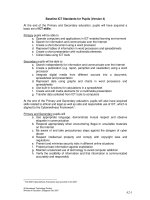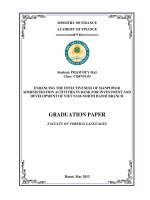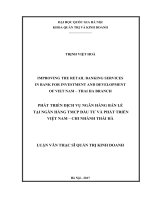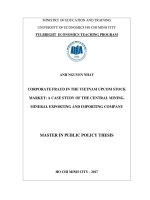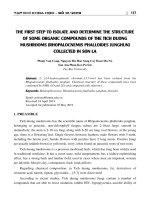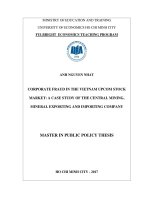The present status of wirtten hmong language in h mong community in the northwest region of viet nam case study in son la
Bạn đang xem bản rút gọn của tài liệu. Xem và tải ngay bản đầy đủ của tài liệu tại đây (5.69 MB, 10 trang )
Journal of Social and
Political Sciences
Nguyen, Trung Kien. (2021), The Present Status of Using Written Hmong
Language in the Hmong Community in the Northwest Region of Vietnam - Case
Study in Sơn La and Lai Châu Provinces. In: Journal of Social and Political
Sciences, Vol.4, No.2, 87-95.
ISSN 2615-3718
DOI: 10.31014/aior.1991.04.02.278
The online version of this article can be found at:
/>
Published by:
The Asian Institute of Research
The Journal of Social and Political Sciences is an Open Access publication. It may be read, copied, and distributed
free of charge according to the conditions of the Creative Commons Attribution 4.0 International license.
The Asian Institute of Research Social and Political Sciences is a peer-reviewed International Journal. The journal
covers scholarly articles in the fields of Social and Political Sciences, which include, but not limited to,
Anthropology, Government Studies, Political Sciences, Sociology, International Relations, Public Administration,
History, Philosophy, Arts, Education, Linguistics, and Cultural Studies. As the journal is Open Access, it ensures
high visibility and the increase of citations for all research articles published. The Journal of Social and Political
Sciences aims to facilitate scholarly work on recent theoretical and practical aspects of Social and Political
Sciences.
Electronic copy available at: />
The Asian Institute of Research
Journal of Social and Political Sciences
Vol.4, No.2, 2021: 87-95
ISSN 2615-3718
Copyright © The Author(s). All Rights Reserved
DOI: 10.31014/aior.1991.04.02.278
The Present Status of Using Written Hmong Language
in the Hmong Community in the Northwest Region of
Vietnam - Case Study in Sơn La and Lai Châu
Provinces
Trung Kien Nguyen1
1
Faculty of Social Sciences, Tay Bac University, Vietnam
Abstract
Writing system is an important part of a certain language. When a language has its own writing system and is
widely used, it is apparent that the language will have a strong position and vitality. Hmong language is a mother
tongue of Hmong people, an ethnic minority that are now residing in many parts all over the world and mainly in
the northwest region (Tây Bắc) of Vietnam. Unlike many other languages which have only one writing system,
Hmong has many different scripts that are being used at a time. Therefore, understanding how Hmong people use
their written language is an intriguing topic to help demystify their language usage and furthermore, understand
their spiritual life. From our practical fieldwork, in this paper we focus on the discussion of the current status of
using written Hmong in its community in the northwest region of Vietnam.
Keywords: Hmong Writing System, Hmong People, Language Usage, Hmong Script, Northwest Vietnam
1. Introduction
In 1961, according to the Decree 206/CP of the Ministry of Education and Training (Decree 206, 1961),
Vietnamese Government officially conceded the use Hmong language system. This event marked a milestone for
Hmong ethnic people in having their official language. This Hmong script was developed and compiled by authors
Van Chinh Nguyen and Thanh Phan based on the Latin alphabet characters via recording voice and taking
phonetics from the people of Flower Hmong (named because of their bright, colorful embroidery costumes
including Hmong Lềnh, Hmong Si) in Sapa region (Lào Cai province) as standard. In addition, they also
supplemented some phonemes of other Hmong groups in other localities. After more than a half of century, until
now, apart from the Hmong writing system compiled by the two authors mentioned above, in the life of Hmong
people in Vietnam, there has also appeared another type of Hmong script which is originated from the outside of
Vietnam known as different names: Laotian Hmong, American Hmong, Regional Hmong, International Hmong,
etc. Therefore, one should keep in mind this highly diverse picture of Hmong written languages in northwestern
Vietnam in relation with Hmong speaking language. In order to evaluate the status of Hmong written usage in this
87
Electronic copy available at: />
Asian Institute of Research
Journal of Social and Political Sciences
Vol.4, No.2, 2021
region, we have carried a case study by surveying 220 Hmong people in Tà Xùa village in Sơn La province and
Sin Suối Hồ village in Lai Châu province. Our result discussed in this paper aims at contributing more realistic
views on the status of using Hmong written in Hmong ethnic community in northwest region (Tây Bắc) of
Vietnam.
2. Content
2.1 Overview of survey region
Tây Bắc is an important geopolitical region of Vietnam. This is not only a large area with 102,000 km2, but also
multifarious in ethnicity with 30 ethnic groups living altogether since a very long time (Tran, 2016). Until now,
the government has given special attention to Tây Bắc region. In particular, the outstanding goals are to maintain
national security, develop a sustainable socioeconomy associated with improving people’s education, preserving
and promoting cultural values of their community.
Tây Bắc now includes four provinces including Hịa Bình, Sơn La, Điện Biên, Lai Châu in which Hmong people
inhabit throughout the whole area. Although Sơn La and Lai Châu are in the same region, but Hmong people in
these two provinces have some distinctive cultural and linguistic characteristics that can be typically representative
for the northwest and northeast parts of Vietnam. This is the main reason for our study to be carried out in these
two locations. In each province, we selected thoroughly a specific surveying area for our study based on their most
prominent properties in which Tà Xùa village of Sơn La province and Sin Suối Hồ village of Lai Châu province
were selected.
Figure 1: Sin Suối Hồ village 2020 (Source: NK Nguyen).
Tà Xùa is a central village of the same name Tà Xùa commune in Bắc Yên district, Sơn La province which can be
considered as the most important part and a core area of Hmong people in Bắc Yên. Here, all inhabitants of Tà
Xùa village and five other highland communes of Bắc Yên are native Hmong people. Today, Tà Xùa has totally
88
Electronic copy available at: />
Asian Institute of Research
Journal of Social and Political Sciences
Vol.4, No.2, 2021
111 families with 650 people. Most of Hmong people living here are Black Hmong (Hmong Đuz). The economic
activities of Hmong people are quite diverse. Besides the traditional agriculture activities such as growing rice,
maize and raising livestock such as cow, buffalo and goat, they also grow green tea, hawthorn and take part in
some touristic activities. Since a long time, Tà Xùa has created its own famous green tea trademarks like Tà Xùa
or Thiên Đường Mây of Tà Xùa (which means “Paradise of Cloud”). Every year, Tà Xùa welcomes about 10,000
tourists. In addition, other business activities in Tà Xùa is also becoming very uproariously.
Figure 2: Touristic high spot Tà Xùa Paradise of Cloud 2020 (Source: NK Nguyen).
Total
651
(100%)
Table 1: Demographic statistics data 2019 in Tà Xùa village (Sơn La province)
Gender
Religion
Profession
Male
Female
338
(51,92%)
313
(48,07%)
0
(0,0%)
Farmer
Merchants
Public servants
Student
542
(83,25%)
23
(3,53%)
9
(1,38%)
77
(11,8%)
Sin Suối Hồ is also a central village of Sin Suối Hồ commune, Phong Thổ district, Lai Châu province. The only
feature that makes this village distinctive from Tà Xùa is that 85% of Hmong inhabitants in Sin Suối Hồ are
Protestants. Nowadays, in this village live 130 families with 674 Hmong inhabitants, in which most of them are
Flower Hmong (Hmong Lềnh, Hmong Si). In the past 10 years, economy of Sin Suối Hồ has seen a remarkable
change, Hmong people in which their lives mainly depend on growing rice, maize and livestock, is now shifting
gradually to new economic activities such as touristic business based on the form of Homestay for tourists and
growing Orchid plant (known as a high income activity in Vietnam). Yearly, Sin Suối Hồ attracts thousands of
domestic and international visitors.
89
Electronic copy available at: />
Asian Institute of Research
Journal of Social and Political Sciences
Total
674
(100%)
Vol.4, No.2, 2021
Table 2: Demographic statistics data 2019 in Sin Suối Hồ village (Lai Châu province)
Gender
Religion
Professions
Male
Female
342
(50,74%)
332
(48,26%)
539
(79,97%)
Farmer
Merchant
Public
servants
Students
545
(80,86%)
37
(5,48%)
11
(1,63%)
81
(12,01%)
We chose these two locations for studying the status of using Hmong written language of Hmong people with
following reasons. First reason is that Hmong people of these two villages (Tà Xùa and Sin Suối Hồ) are all native
Hmong that belong to Flower Hmong (Hmong Lềnh, Hmong Si) and Black Hmong (Hmong Đuz). The second
reason is that the two villages are also very active in touristic activities, this means that the local people here
communicate very frequently with people from other ethnic groups and other locations including foreigners. In
the third reason, both Tà Xùa and Sin Suối Hồ locate in the central part of their two communes. For the fourth
reason of this survey is that the two villages have a distinctive features in term of the religion of their inhabitants.
Most of Hmong people in Sin Suối Hồ are Protestants while in a contrast, in Tà Xùa, all inhabitants are
non−religious. Those typical features are the main reasons for us to choose these two villages to investigate
because they possess many similarities as well as dissimilarities.
Figure 3: Hmong ladies with traditional costumes in a dance performance for tourism activities in Sin Suối Hồ
village 2020 (Source: NK Nguyen).
90
Electronic copy available at: />
Asian Institute of Research
Journal of Social and Political Sciences
Vol.4, No.2, 2021
2.2 Overview about Hmong writing systems
Hmong ethic people have a long history and they reside in many different regions in the world (Nguyen, 2017).
Hmong language is now the native language of about 10 million people inhabiting in different countries. Despite
a long history of existence, many researchers in the world and in Vietnam have agreed that ancient Hmong
language has no writing system (Ly, 2009) although in Hmong mythology, it was told from generation to
generation that their ancient language has a script, but unfortunately the script was “eaten by a cow” Nowadays,
in the Hmong’s belief, particularly during their important events such as wedding feast, funeral, New Year holiday
or naming ceremony for newborn baby etc. Hmong people usually use a white paper carved with many little holes
that create special patterns. They believe that those patterns are the special codes of Hmong script that have been
passed on from their ancestors. Then this devoted wish of having a writing system for Hmong people has now
come true. To date, Hmong is one of the very few languages which has different writing systems at a time.
In China, in 1904, missionary Samuel Pollard, as first set his foot in Yunnan China had compiled a Hmong script
which was then called the Hmong Pollard. Hmong people in Yunnan afterward learned and knew this kind of
script, they wrote Christian Bible and Hymn in Hmong Pollard. From 1949 to 1954, Chinese Government released
three sets of Hmong scripts which were developed based on Latin alphabet system in three regions, namely
Guizhou Hmong, Hunan Hmong and Yunnan Hmong. These three writing systems are different in number of
consonants, vowels and tones. Nowadays, in these areas, Hmong people are still using these scripts for writing.
In Laos, throughout 40 years from the 50s to 90s of the twentieth century, four Hmong writing systems were
established. Specifically, the Hmong Txwj Zeb script was created in 1950, Hmong Latin script (1953), Hmong
Song Lu (1959), Hmong Tsuj Yig (1997). Among these scripts, the Latin Hmong script to which the Hmong people
often called as the International Hmong (the English name for this Hmong script is Romanized Popular
Alphabet−RPA or Hmong RPA) is the most influential. Today, Hmong people in Laos, Thailand, US, Australia,
Canada... have agreed to use the International Hmong writing system as standard syllable for transliteration
(Nguyen, 2016). The International Hmong script is recorded based on the White Hmong (Hmong Đơ) dialects. As
a consequence, they have used this Hmong script to create many cultural and media publications.
In United States in 1990 and in Thailand in 1991, there appeared the Hmong pictograms as the patterns decorated
on their costumes. However, this pictogram−based script had no strong vitality and popularity in Hmong
community.
In 1917 in Vietnam, priest Father M. Savina had compiled a Hmong phonetic script in populating the Protestantism
in the Hmong living areas. Unfortunately, this script have been no longer used as there is almost none of Hmong
person in Vietnam knows how to use this script. In 1961, the Government of Vietnam approved the Mèo (Miao)
script−another so-called name of Hmong written language in Vietnam (Decree 206, 1961). Two authors, Van
Chinh Nguyen and Thanh Phan had compiled this Hmong script based on the Latin characters, taking the Flower
Hmong dialect (Hmong Lềnh, Hmong Si) of Sa Pa (Lào Cai province) as standard. This Hmong script has been
used for teaching in many Hmong living regions in Vietnam until now and was usually called as Vietnamese
Hmong.
2.3 Results and Discussions
2.3.1 The literacy status of Hmong people in the surveying areas
The result in the Table 3 shows that if considering in term of quantity, the number of literate Hmong people (ability
to read and to write with Hmong script) is quite high. In Tà Xùa, the percentage of literate Hmong people is 60,90
%, while in Sin Suối Hồ, this rate is even higher which is up to 92,72%. In term of the age, most of Hmong people
that are able to use Hmong script are under 60; there is obviously no difference in term of gender between the
number of men and women that know Hmong script. In terms of occupation variables, Hmong students have the
highest literacy rate, then followed by public servants and finally those who are merchants and farmers. However,
91
Electronic copy available at: />
Asian Institute of Research
Journal of Social and Political Sciences
Vol.4, No.2, 2021
if considering the literacy rate in term of religion, there is a very clear difference among people which are in
different religions. Hmong people who are Protestants in Sin Suối Hồ have much higher literacy rate compared to
non−religious Hmong in Tà Xùa. Table 6 shows that number of Hmong people who are illiterate in Hmong writing
in Tà Xùa is 39,10%, while that number in Sin Suối Hồ is 7,28% and all of them are over the age of 60. It is worth
noticing that despite many Hmong people do not know Hmong writing, but they are very fluent in oral
communication in Hmong language. Many of those are shamans and priest in Hmong community. This means that
they teach Hmong language to their descendants via oral communication.
Village
Tà Xùa
Sin Suối Hồ
Table 3: Study result on the number of literate Hmong people
Number of
Ratio
Know Hmong script
Do not know Hmong script
people
(%)
Number of
Percentage
Number of
Percentage
people
(%)
people
(%)
110
100
110
100
102
92,72
8
7,28
2.3.2 Current status of using Regional Hmong and Vietnamese Hmong
The survey result shown in the Table 4 reveals that total number of people who know Hmong written language,
the proportion of Hmong people who know each type of Hmong scripts has a large difference. For example, the
number of literate Hmong people in Tà Xùa and Sin Suối Hồ who know “Regional Hmong” script takes a large
percentage of 89,55% và 98,03%, respectively. In a contrary, the number of Hmong that know “Vietnamese
Hmong” script is very low of 8,19 % và 2,73 %, respectively. It is worth mentioning that the Vietnamese Hmong
script created in 1961 that was originally compiled based on phonetics of Flower Hmong (Hmong Lềnh, Hmong
Si), these Hmong people are also now living in Sin Suối Hồ. Thus, if assuming that the Vietnamese Hmong script
are not popular in the Hmong ethnic community because of the phonetic difference between different Hmong
groups is absolutely unconvincing in our opinion. Because today, Hmong people inhabiting in Sin Suối Hồ are
Flower Hmong (Hmong Lềnh, Hmong Si). Considering at certain aspect, one might probably think that they should
have felt familiar with Vietnamese Hmong script which was originally based on their phonetics. However, the fact
that they feel “alienated” with this Hmong script is so unexpected. Meanwhile, the Regional Hmong script
(International Hmong) which was compiled based on the phonetics of White Hmong (Hmong Đơ), a different
Hmong group, those are not inhabitants of these two regions indeed has been widely used here. Then the question
is “why is there such a high number of the Hmong people that know and use that Regional Hmong script?” To
answer this question, we need a further investigation. Is it because of a fact that Regional Hmong has many
published journals and books, then many Hmong people can use it? From our fieldwork in the location, we realized
that most of Hmong people know Regional Hmong script (International Hmong) by self−learning and
self−researching. In this scenario, they will learn the language by methods in which a person with better Hmong
written knowledge will teach those who knows little. And in turn, the person that knows very little Hmong script
will teach those who do not know any Hmong word. In fact all of them have never participated in any official
language class. By self−learning, Hmong people in Tà Xùa village where is not influenced from Protestant religion
still has a rate of literacy up to 60,9%. In Sin Suối Hồ, a religious region where most of Hmong are Protestants to
which learning Regional Hmong is a mandatory (to read and understand Protestant Bible), the rate of literacy in
Regional Hmong occupies 92,72% which is of course understandable. The above analysis from our data has shown
different aspects of the whole picture in using different Hmong writing systems in Hmong ethnic community in
the northwest region of Vietnam.
Village
Tà Xùa
Sin Suối
Hồ
Table 4: Study result of Hmong who know all type of Hmong characters
Total number
Ratio
Regional Hmong
Vietnamese Hmong
knowing Hmong
(%)
Number
Percentage (%)
Number
Percentage
(%)
67
100
60
89,55
7
10,45
102
100
100
98,03
2
1,97
92
Electronic copy available at: />
Asian Institute of Research
Journal of Social and Political Sciences
Vol.4, No.2, 2021
2.3.3 The purpose of learning Hmong script
The study result shown in the Table 5 on the purpose of using Hmong script reveals that all Hmong people in Tà
Xùa and Sin Suối Hồ use Hmong script for communicating purposes (for sending message) and entertainment (for
watching movies and films) with 100% of people in both locations. On the other hands, they use the Hmong script
for reading and writing books with lowest rate of 10% and 1% in Tà Xùa and Sin Suối Hồ, respectively. Particularly
in Sin Suối Hồ, because of the need in reading and understanding the Protestant Bible, it is a compulsory
requirement for the believers to learn Hmong script. For this purpose, all people here want to learn Hmong written
language. From this aspect, one can see that Hmong writing system together with its speaking language are very
important tools to connect the individuals inside the Hmong community, especially in term of their religion, which
help them protect, preserve and pass on their cultural and spiritual values as well as connect individuals in a
community.
Table 5: Study on the purpose of Hmong people in learning Hmong script
Purpose of using Hmong
To
To send
Watch
To sing
To read
To
script
write message
TV and
karaoke
books
write
a
video
and
papers
letter
magazine
s
Tà
Number of
67
5
67
67
38
6
0
Xùa
people
Ratio (%)
100
7,46
100
100
56,71
8,95
0,00
Sin
Suối
Hồ
Number of
people
Ratio (%)
To read
Protestan
t Bible
0
0,00
102
8
102
102
89
15
2
102
100
7,84
100
100
87,25
14,70
1,96
100
2.3.4 The attitudes of Hmong people in leaning Hmong script
Now let take a look at the data shown in the Table 6 which reveals that the number of Hmong people that like
learning Hmong script occupies a high rate of 91,81% in Tà Xùa and 97,27% in Sin Suối Hồ. On the other hand,
those people who dislike learning Hmong script are almost elderly. They said that they are quite old to learn how
to write and to read Hmong script, thus they are not interested in learning. Otherwise, all the people who were
questioned said that they want to learn Hmong and quốc ngữ script (official language of Vietnamese). To this
desire, in our opinion, this is very legitimate and practical. The Hmong script in any type is an effective tool for
the Hmong people to preserve their culture while “quốc ngữ” script is an important tool to help the Hmong
integrate with the general development of the country and in addition with Kinh society (main ethnic group in
Vietnam) in the main land. Our practical fieldwork study shows that Hmong people do not have stigmatized
attitudes towards the different types of Hmong script. They believe that with any Hmong writing type, it only
needs to be simple to learn, to remember and to use; it can be used to exchange information, their feelings and
their love in the community. If one written language meets those requirements, then it can be considered as useful
and valuable (the opinion of Ms. Thi My Giang, 28 years old in Sin Suối Hồ village). Actually, we believe such
opinion on leaning Hmong script in Tà Xùa and Sin Suối Hồ comes from their love to their language. To some
extent, such opinions may become suggestion in planning of the language policy and the cultural management for
the Hmong people in Vietnam to find solutions that are suitable and effective in teaching and disseminating the
Hmong script in the Tây Bắc, Vietnam.
93
Electronic copy available at: />
Asian Institute of Research
Villages
Tà Xùa
Sin Suối Hồ
Journal of Social and Political Sciences
Vol.4, No.2, 2021
Table 6: Study on the attitude of Hmong people with Hmong language
Number of
Ratio (%)
Like learning
Do not like learning
people
Number of
Ratio
Number of
Ratio (%)
people
(%)
people
110
100
101
91,81
9
8,19
110
100
107
97,27
3
2,73
3. Conclusions
In summary, in the daily life of Hmong community in the northwestern region (Tây Bắc), Vietnam, they use two
sets of Hmong scripts namely Vietnamese Hmong (released in 1961) and the Regional Hmong (imported from
other Hmong communities outside of Vietnam). The similarity of these Hmong writing systems is that they use
Latin characters to record the Hmong voices by different techniques. Nowadays both types of Hmong script are
still being used in different regions at different levels depending closely on many factors such as religion,
frequency of contacting with other individuals from other lands or with published Hmong written books and
magazines or by self−learning method among Hmong individuals in each community. In addition, Hmong people
also contact quite often with the Vietnamese Hmong script via the programs broadcasted from governmental and
local television channels. The contingent of public servants who are Hmong and other ethnic personnel are making
great efforts in studying Hmong script in order to obtain Hmong language certificate (Decree of Vietnamese
Ministry of Education and Training, 2006) which is important so that it can be used to propagate and educate
Hmong people with the governmental policies and documentary. On the other hands, these staffs can transfer new
technology and engineered achievement through documents in Hmong language. However, Hmong people living
in the Tây Bắc region, more specifically, those living in our survey area are standing on the brink of being illiteracy
in Vietnamese Hmong, in a contrary they understand better and use more frequently the Regional Hmong. This
paradox, according to our opinion, one should continue to study in order to find out a suitable solution for the
problems in learning written Hmong.
Table 7: Questioning table used to interview
1.
2.
3.
4.
5.
6.
7.
8.
Do you (Sir/Madame/Mister/Miss) understand any type of Hmong script?
Could you please read the following Hmong script?
What kind of Hmong script do you know? (The Vietnamese Hmong or the Regional Hmong (the
International Hmong)?
For what purpose are you using Hmong script?
Do you have books or newspapers written by Hmong in your family?
Do you like learning Hmong script?
Why do you like learning Hmong script?
By which methods have you learned the Hmong script?
Table 8. The paragraph written in Vietnamese Hmong script used for the survey
Cur tsêr nhaoz ntơưv ntangr trôngz saz. Tsêr khoangz thaov haz lăngx nzas. Tsêr tuôr cxangx. Kraor yoangz
zênhv thaz kraor trôngx zaos muôz ntông uô. Tsêr vur vuôl, ndêx tsêr zaos têx tul ntông lux thaz khênhx, yangr
puôv đrangr phaos thaz hur si. Cur tsêr hax muôx iz luz rơưr đêx cxiv thưr chiz. Đêx tâu chu lơưr tul char đêx
pêv kraor đêx lul. Cur luz tsêr tưz uô ntêr lul lak, tangz tsênhv chuô yaz cha. Ndis lênhl tao vangx, tao tsêr muôx
ntâu zangv ntông naox txir (Nguyen, 1996).
(Lao Cai College of Education, Tài liệu học tiếng Mông, p.52)
Table 9. Paragraph written in Regional Hmong (International Hmong) used to survey
Kuv lub tsev
Kuv lub tsev nyob puag saum toj roob siab. Kuv lub tsev dav thiab nyob laj cua heev, lub tsev yog tsev puab
av, qhov rooj tsev yog muab ntoo ua. Saum qaum tsev vov vuas. Sab nraum tsev yog ib lub tiaj huv si thiab
94
Electronic copy available at: />
Asian Institute of Research
Journal of Social and Political Sciences
Vol.4, No.2, 2021
muaj ib lub pas dej siv gạch nkaig ua. Dej ntws raws lub raj puas pem hauv dej los. Kuv lub tsev twb ua tau
ntev heev lawm tiam sis ntshia tseem zoo thiab tsiab heev. Nyob ib ncig kuv vaj tse yog txiv xyoob txiv ntoo.
(this paragraph was written by Thi My Giang, preschool teachers, Sin Suối Hồ village)
References
Decree (2006), Vietnamese Ministry of Education and Training decided to issue the Hmong language program in
order to train the Hmong language teacher for the cadres and civil servants working in ethnic minority and
mountain areas, Hanoi.
Trần Trí Dõi (2016), Ngơn ngữ các dân tộc thiểu số ở Việt Nam, Nxb Đại học Quốc gia Hà Nội, Hà Nội.
Lý Tùng Hiếu (2009), Xây dựng, sửa đổi chữ viết các tộc người thiếu số ở Việt Nam: Những quan niệm phiến
diện về công năng của chữ, website: http//www.vanhoahoc, Hồ Chí Minh.
Nguyễn Trung Kiên (2017), Dân tộc Mơng và tiếng Mơng ở Việt Nam, Tạp chí Ngôn ngữ và Đời sống, số 2, Hà
Nội.
Nguyễn Năng Tân (1996) (Ed), Hmôngz ntươr, Nxb Giáo dục, Hà Nội.
Nguyễn Kiến Thọ (2016), Vấn đề lựa chọn chữ Mông trong đào tạo, bồi dưỡng tiếng Mơng hiện nay (Nhìn từ
thực tiễn hai tỉnh Bắc Kạn và Thái Nguyên), Tạp chí khoa học Đại học Tân Trào, số 3, Tuyên Quang.
Prime Minister (1961), Decree 206−CP dated on November 27, 1961, Hanoi.
95
Electronic copy available at: />


